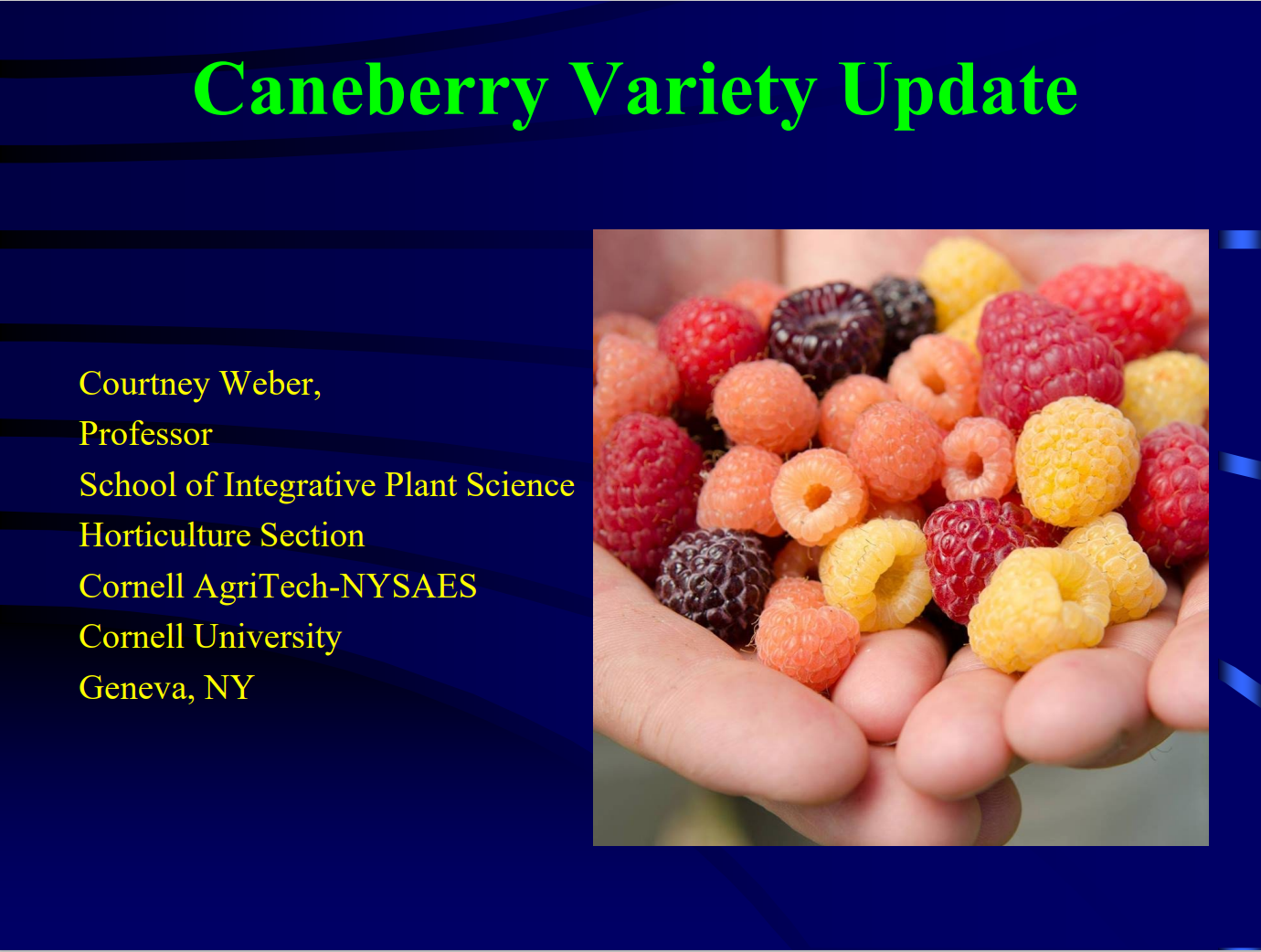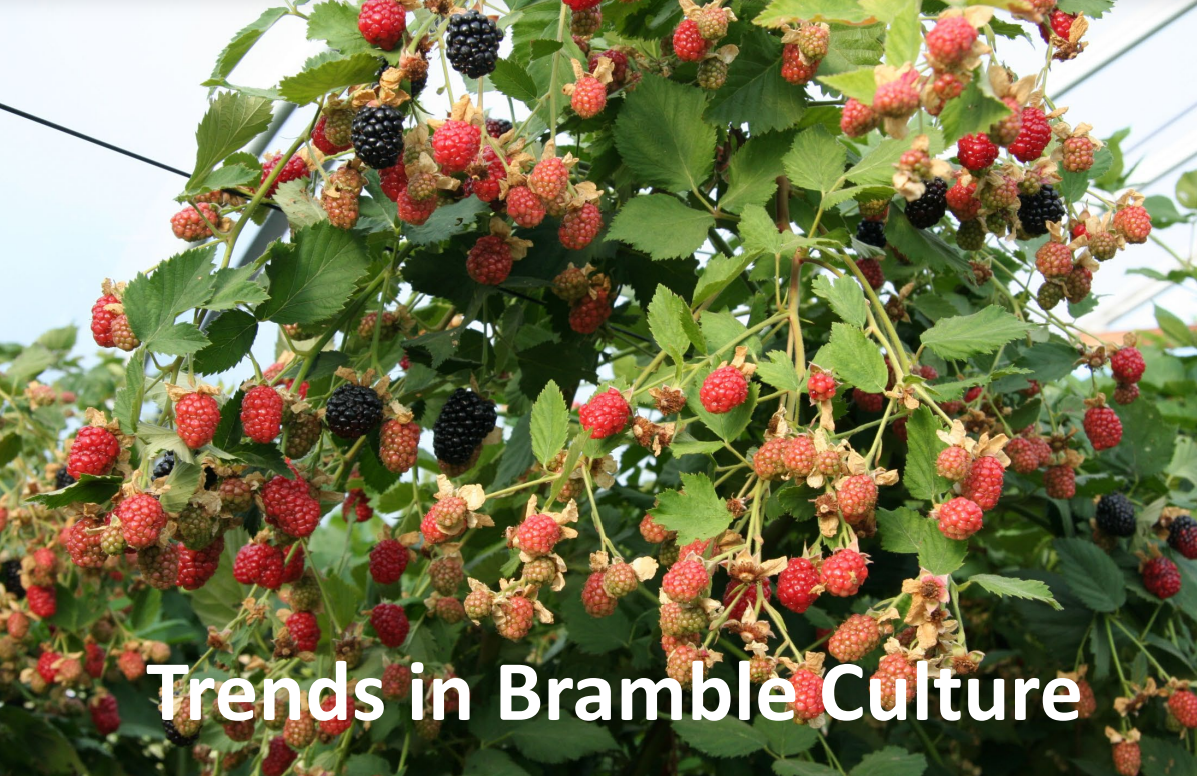At the 2024 Empire State Expo, a variety of experts presented recent findings on berry studies and trials. They’ve kindly shared their presentations with us, which you can access here by clicking on the link beneath each photo. From trends in bramble culture to blueberry pruning, managing anthracnose resistance, and a unique rotating cross-arm trellis system, these presentations represent some of the newest and most innovative techniques in berry growing.
Get Your 2023 Updated Version of the Berry Crop SWD Insecticide Quick Guide
By Laura McDermott, CCE ENYCHP
By now, most growers are familiar with the Quick Guide to insecticides that are effective in preventing SWD infestation. There are a few very minor changes in this year’s version of the Quick Guide, most notably that Cyclaniliprole is labeled in blueberries and caneberries for SWD, but not in strawberries. Over the years, more materials have been made available for use on all berry crops, but notably, strawberries have fewer options. Please always check the label for specific guidelines and restrictions.
Get your free, downloadable copy of the current Insecticide Quick Guide here.
What You Need to Do for a Successful Blueberry Harvest This Summer
Our friends at Cornell Cooperative Extension have shared these important tips for ensuring the success of this season’s blueberry crop.
Blueberry harvest is underway and looks surprisingly good in most places – despite the May freeze, early drought, and occasional hail events around the region. Fruit is sizing very well and plant growth is great – these plants LOVE all this rain! But unexpected weather is when you will discover how effective your disease management program was.
Anthracnose fruit rot (Colletotrichum acutatum) is widely apparent in plantings. This disease should be prophylactically sprayed before and during bloom. You can spray now in hopes that you can thwart the spread of the disease, but look carefully at the REI and days to harvest all chemicals.
This disease will present as a sunken spot on the fruit. In this humid weather, you will undoubtedly see the pink-orange fruiting spores that will grow on the sunken areas. Make a note to focus on next season to control this disease.
Mummyberry (Monilinia vacinii-corymbosi) is less widely apparent, but definitely out there. Mummyberry spores can be moved by pollinators, so even if you’ve never dealt with this disease before, there is always a chance. That is why we encourage growers to manage for it, despite the history in your own patch. This disease is controlled at the vegetative green tip – so pretty early in the spring.
Blueberry tip borer moth (Hendecaneura shawiana) is a pest that we are seeing much more frequently than in the past. The pest doesn’t damage the fruit from this season. But the overall impact is more significant. The moth lays eggs in the tip of the newest canes, causing the cane to abort vertical growth and branch much lower than it normally would. This means that there is less opportunity for overall growth, the fruiting wood is too low, and over time the plant becomes less productive due to the architectural change.
The small brown moth lays eggs in June, which hatch in July. The larvae drill down several inches, causing distortion and then death of the shoot tip. This flagging can look something like canker, but it’s more localized to the top 6” of the shoot. There are no labeled conventional insecticides. Use azadirachtin and pyrethrin products at petal fall for control.
Japanese beetle (Popillia japonica) have started feeding on blueberry foliage. I’ve yet to get a report of fruit feeding, but that is when they become a problem worthy of spraying. Despite the foliar damage, they usually don’t do lasting damage to the plant. There are many pesticides that can be used on this insect, but don’t pull the trigger unless you really need to and make sure to read the label for Days to harvest.
Canker diseases (Fusicoccum putrefaciens and Phomopsis vacinii) are exhibiting the tell-tale cane flagging. New shoots will wilt rapidly and die back from the tip towards the crown. Healthy vigorous canes will wilt and collapse. When you see this happen in an otherwise perfectly healthy plant, the likelihood is high that it’s canker. Fusicoccum canker forms bulls-eye type lesions on the stem, which is another diagnostic help. Prune the dead out as it appears and make a note to use a delayed dormant spray next spring.
May Berry Maintenance
May Berry Maintenance
Adapted from Cornell ENYCHP’s Berry News
Strawberries
Inspect irrigation equipment and row cover. Make sure you have an adequate temperature detection system at the field level, especially for frost protection.
Red stele, the common name for root and crown rot of strawberry, is caused by the fungus Phytophthora fragariae. Leather rot of the fruit is caused by Phytophthora cactorum. Earlier in the season, Ridomil and phosphorus acid products (such as ProPhyt) are recommended as soil drenches in fields where flooding was a problem last fall. Those same products can be added to bloom sprays if extended wet fields or overhead iirrigation because of frost were problems, or if leather rot has been a problem in past years. Add these products at first bloom. Straw mulch helps minimize the water splashing that spreads leather rot.
Spray early for best leaf spot control, if leaf spot incidence has been increasing in your area.
Consider strawberry pre‐plant herbicide options. Prowl H20 or Chateau are both great. Depending on your weed pests, you may want to try Dual magnum or Goal 2XL. Both of them have timing limitations, so read the label carefully.
Blueberries
Green tip sprays for mummyberry and Botrytis should be applied now. Abound and Indar are labelled for both diseases, but there are other choices as well. Check the guidelines on the label.
Prepare for nutrient applications in May and again in early June. Review foliar tests. Apply sulfur if soil pH is higher than 5.2 – 200#/A is the maintenance rate that should be applied 1‐2 times annually to prevent soil pH from creeping up. Remember that the target pH is 4.5. Make sure soil boron or foliar boron tests show that those levels are appropriate.
To improve pollination of blueberries, plan on adding bumblebee hives into the planting. Stocking density of hives varies greatly depending on the variety of berry you are growing. Ask your local extension agent for details.
Brambles
Brambles are breaking dormancy in all but most northern locations.
Complete the necessary pruning, to keep cane density at no more than 4 canes per square foot. There may be some winter injury, so look for that and prune it out.
Bud break is the trigger for sprays to control anthracnose, spur blight, and cane blight.
Apply early season herbicides. Casoron 4G (granular) can be used in caneberries. The same caveats listed above for blueberry apply. Casoron CS can be applied a bit later, but still needs to be incorporated by rainfall, before weed germination; it is labeled for blackberry and raspberries if applied before new shoot emergence. Don’t delay: you are running out of time, and the southernmost counties are likely too far along to use Casoron safely and effectively.
Watch for raspberry fruitworm feeding on new leaves.
Juneberries (Saskatoons)
Now is the time to spray for apple curculio and/or saskatoon sawfly if you’ve had damage in past years. The larval stages of these insects feed inside the developing berries, resulting in fruit losses or the presence of insects inside fruits at harvest. Treat if damage to berries exceeded 10% last season. Products include Molt‐X (10 fl oz/A) or SuffOil‐X (1 – 2 gal/100 gal) or PyGanic 1.4 ECII (16‐64 fl oz/A).
There are relatively few pesticides registered for use on this crop. Even for products that are registered, there is limited information on the efficacy of the active ingredients against specific saskatoon pests. Therefore, the recommendations are based largely on how well the pesticides are known to work on related pest species on other fruit crops.
Ribes
Powdery mildew sprays (many organic options including oil, Kailgreen, sulfur and Actinovate, but also Rally, Cabrio, and Rampart) should begin now if this has been a problem in the past.
Cornell’s Juliet Carroll Earns Excellence in IPM Award
Dr. Juliet Carroll, Fruit IPM Coordinator at Cornell University, earned the Excellence in Integrated Pest Management (IPM) Award from the New York State Integrated Pest Management Program (NYSIPM) at the Viticulture day of the B.E.V. (Business, Enology, Viticulture) conference in Rochester. The award honors individuals who encourage the adoption of IPM in their businesses, schools, communities, and farms, and who develop new tools and tactics for sharing these practices.
Dr. Carroll spearheaded the expansion of NEWA, a website and network that allows growers to understand how the weather will affect fungal and insect pests, and takes the guesswork out of their pest-management strategy. Carroll ran NEWA for over a decade. Under her leadership, NEWA went from 45 weather stations in New York State to over 500 in 12 states. Her work, along with Wayne Wilcox and Greg Loeb, on improving the user experience with the grape disease and grape berry moth models on NEWA, had an enormous impact on the implementation of grape IPM in New York.
Dr. Carroll also led the development of Trac software. Introduced in the early 2000s, the software simplified and digitized pesticide recordkeeping for large and small growers and processors alike. It allows farmers to input the information once, and generate customized reports for different processors. The software also includes reference to “IPM Elements” for grapes and other crops—a tool that helps growers assess their pest management practices.
Dr. Carroll built Trac software for five fruit crops, and partnered with a colleague to create TracTurfgrass for golf, lawns, sports fields and sod farms. Luke Haggerty, grower relations representative for Constellation Brands, calls Carroll’s TracGrape software “a true breakthrough” in recordkeeping. Of her work with NEWA, Haggerty says, “Julie has always been very proactive in developing and delivering the products needed for our growers to produce grapes in an environmentally and economically sustainable way.”
Tim Martinson, Cornell Cooperative Extension Viticulture specialist, noted, “IPM is built on information and decision-making tools. Juliet has built TracGrape and NEWA into useful, practical tools for growers.”
Dr. Carroll also co-edited organic production and IPM guides for grapes and several berry crops, and has regularly presented at Lake Erie Regional Grape Growers’ conferences and Coffee Pot meetings. She has conducted research on devastating pests, such as spotted wing drosophila (SWD), investigating whether hungry hummingbirds can provide meaningful control.
In addition, Dr. Carroll has chaired the Northeast IPM SWD working groups for the past decade, bringing research scientists, growers, industry reps, and extension educators from across the region together to help find solutions. Carroll has also helped fruit growers with bird management.
Learn more about integrated pest management at nysipm.cornell.edu.















